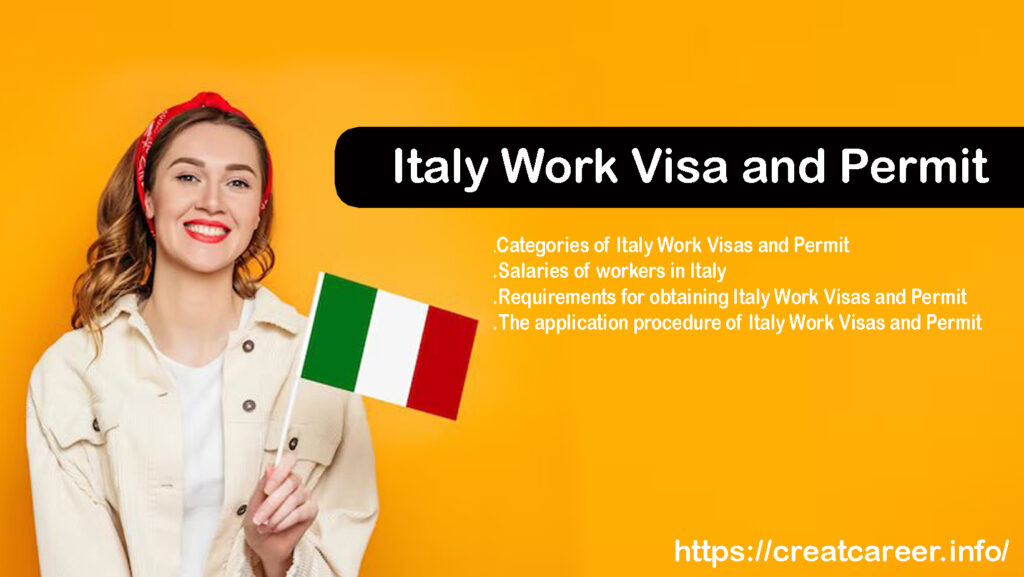Italy is a popular destination for work, with a strong economy and a wide range of industries offering opportunities for job seekers. The country is also known for its high quality of life and its beautiful scenery.
Thank you for reading this post, don't forget to subscribe!Categories of Italy Work Visas and Permit
Italy permits citizens of other EU members to work there without a specific visa or permission because it is an EU member. It is also permissible for nationals of EEA member states to work in Italy. Workers who are not nationals of the EU or EEA must get a Nulla Osta work visa in order to enter Italy.
Work visas are classified as long-stay visas in Italy; they are also known as national or D-visas. It’s crucial to remember that an Italy work visa and permit are required for employees. Upon arriving, they will require a residence permit in order to remain in Italy.
Salaries of workers in Italy
| Industry | Average annual salary (€) |
|---|---|
| Healthcare | 34,560 |
| Legal | 24,360 |
| Accounting/finance | 22,176 |
| IT | 34,560 |
| Journalism | 53,520 |
| Engineering | 40,680 |
| Advertising/design | 26,040 |
| Retail | 16,920 |
| Construction | 19,440 |
| Hospitality | 14,880 |
| Teaching | 31,560 |
These salaries are based on data from Indeed and Payscale, and are for illustrative purposes only. Actual salaries may vary depending on the individual factors mentioned above.

Requirements for obtaining Italy Work Visas and Permit
Applicants seeking a work visa from non-EU and non-EEA nationals must be employed in Italy prior to filing their application. They will also require aItaly Work Visas and Permit, which the company must apply for with the employee’s supporting documentation.
The following supporting documentation must be submitted by your staff with their application for a work visa in Italy:
- An extra copy of the original Nulla Osta and a signed employment contract
- A filled-out application form for a long-stay visa
- Proof of sufficient funds, lodging in Italy, and payment of the visa fee
- Passport photos
- A minimum of two blank pages in the passport that are valid for at least three months after the visa’s expiration date
- Diplomas and other qualifying certificates
The application procedure
When a worker receives an employment offer in Italy, the procedure for obtaining a Nulla Osta starts. The following actions must be taken in order to receive a work visa:
- The employer goes to the immigration office in the Italian province where they are located and asks for a work permit.
- After the work permit is approved, the company will contact the Italian embassy or consulate, where the worker will submit an application for a Italy Work Visas and Permit, and transmit the permission to the worker.
- The worker will get the Italy visa application form, fill it out, gather the required paperwork, and apply in person at the Italian embassy or consulate.
- The employee has six months to pick up the visa and enter Italy if the Italian authorities approve the application.
- The employee has to apply for a residency permit, also known as a permesso di soggiorno, within eight days after arriving in Italy. The application can be picked up at a local post office.
Depending on the terms of the job contract, an Italy work visa may be valid for up to two years; however, it may be extended for up to five years.
Other important factors of Italy work permit and visa
The fact that applications for work permits are only granted for a few months every year or two is one of the special factors to take into account while applying in Italy. Depending on the Italian labour market and immigration status, there are differences in this application window. The Italian government will also only grant a certain number of work permits within a specific time frame. Although highly qualified workers could not be subject to the quota, they will still need to follow the proper procedures for obtaining an italy work permit and visa.
Italy raised the number of work permits available to non-EU and non-EEA citizens from 69,700 to 82,705 as of January 30, 2023.
Learn how to manage your international teams with the aid of G-P.
At G-P, we’re dedicated to removing obstacles in the way of international trade, creating opportunities for everyone, everywhere, and assisting businesses in realizing the full potential of their workforce. Regardless of your workers’ location, we assist you in staying in complete compliance with local regulations and make sure that everything, from recruiting and onboarding to paying them, is simple and quick.



